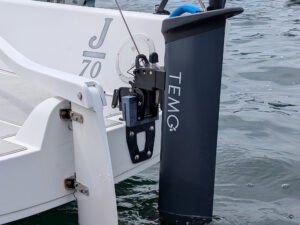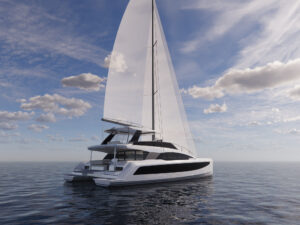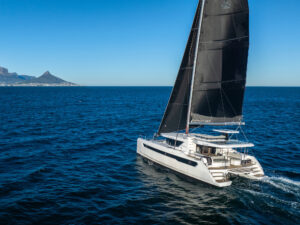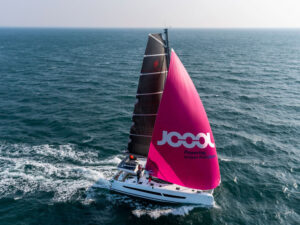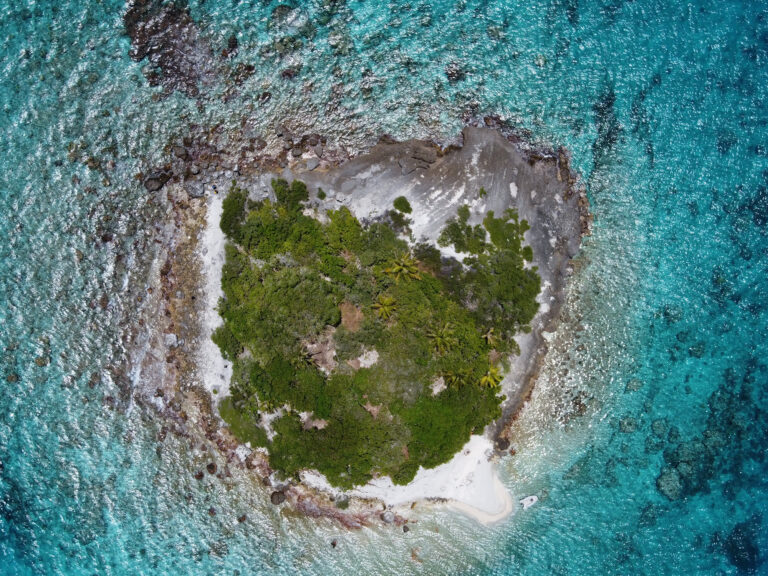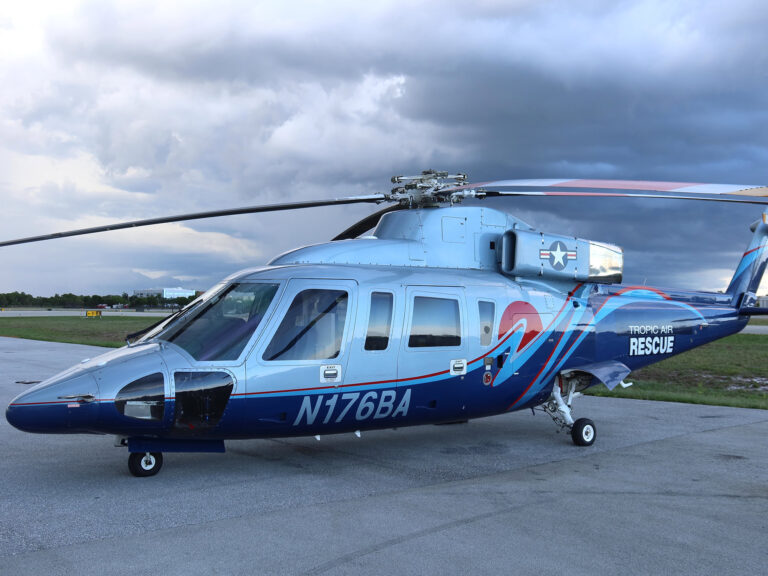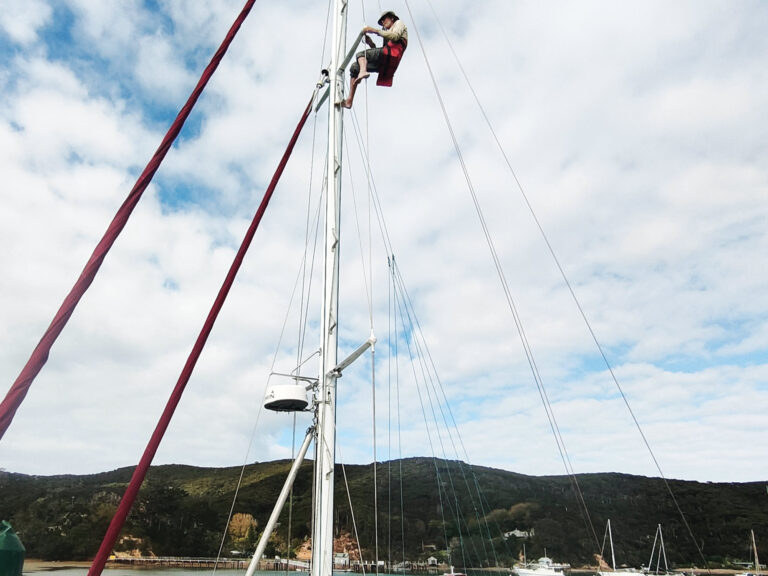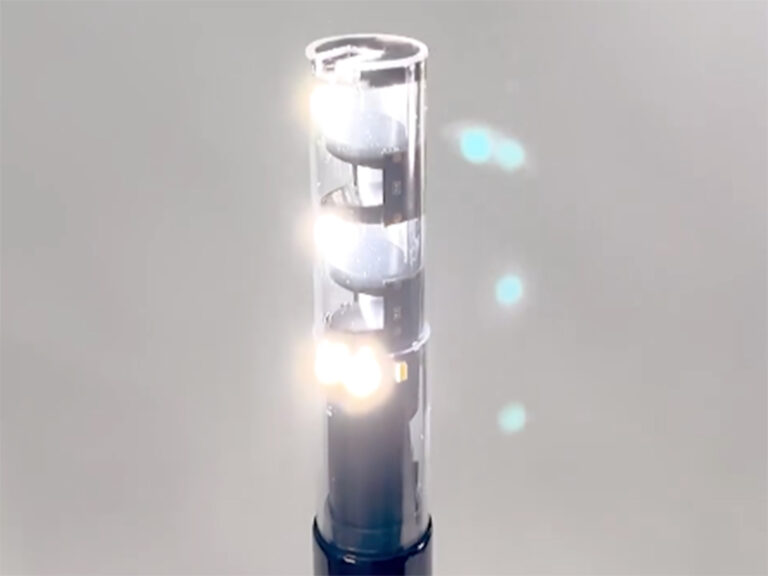
As Cruising World‘s Boat of the Year judges evaluate the latest crop of cruising sailboats each year, we inevitably see new trends emerge in all the detailed aspects of yacht design. Over the next several months we’ll explore some of these trends both in deck layout and interior appointments. For now, we’ll look at the latest sailhandling systems: mainsails, headsails and how general deck layout affects the actual work of sailing.
A decade ago, the new trend in line-handling design was to bring as much running rigging as possible — halyards, sheets, vangs, travelers, topping lifts, reef lines — back to the cockpit. For these jobs, banks of rope clutches came to replace cleats on the cabin top. This arrangement simplified maneuvers, particularly for shorthanded crew, keeping sailors in the cockpit and off the foredeck.
Through the intervening years, this trend has certainly held. In the 2018 fleet that we inspected during and right after the U.S. Sailboat Show in Annapolis, Maryland, we saw that theme further developed; designers of most new models now lead that running rigging through covered composite channels under the coachroof or deck. Aesthetically, this feature produces an impressively clean look on deck. Functionally, it eliminates tripping hazards for the crew. As we examined these fairleads boat by boat, though, my judging colleagues and I recognized that turning blocks require occasional maintenance or hockle clearing, and sometimes sailors might want to open the entire channel for a good visual inspection.
Arguably the two cleanest deck profiles in the 2018 fleet were those on the Swan 54 and the Hanse 588. On the Swan, all running rigging coming down the mast passes through high-quality, low-friction blocks, then runs inside a tunnel in the coachroof and exits near the aft end of the cockpit coaming before passing through clutches. In this installation, there is no removable cover; the tunnels are a permanent element of the deck part. It contributes to one of the lowest-profile cabin tops in the fleet, matched only by the Hanse 588. On the Hanse, the turning blocks are installed underneath a cover that runs along the outer edge of the coachroof, and the cover can be removed by taking out several machine screws. Teak decks cover the cabin tops of both boats. In both cases, there’s barely a step up to the cabin top.
The Moody 54 DS, built by Hanse Yachts on the same hull as the 588, employs covered sheet runs to a different purpose. With the Moody’s raised decks, shin-high bulwarks and waist-high solid rail all along the outboard edge of the side decks, the covered running rigging contributes to an exemplary clear passage between the cockpit and the foredeck.
A fundamental reason why the new Jeanneau Sun Odyssey 440 won CW‘s 2018 award for Most Innovative was its side decks, which incorporate transformable cockpit coamings and an uncommonly safe walkway forward from the aft end of the cockpit. The Jeanneau’s covered headsail-sheet runs were an integral component of that design.
As an aside, watch for covered runs that require you to break a caulk bond in order to gain access. The Beneteau 51.5 offers a hybrid: caulked covers over the straight-line runs, but with separate covers over the turning blocks that can be removed with fasteners. It’s a neat solution.
Shaping the Main
Your mainsail’s shape — both in its original construction and in real-time sailhandling — fundamentally shapes the experience you’ll have on the water, whether or not you consciously recognize that it’s doing so.
A bagged-out hollow-roach mainsail will positively sap the spirit of a boat, not to mention its crew. The boat’s motion will be sluggish; it’ll heel more than necessary and fall away off its mark. That said, with a well-built sail, the control you have to move the draft and twist the leech will spark a boat right up and take a world of load off the helm. Some builders offer plenty of sail-shaping control; others believe their owners want the fewest possible strings to pull on.

Lines
For shaping the main, you’ll get the most control with a traveler installed at the aft end of the boom and running as wide as possible. Of course, the winners here are the catamarans. Every cat in the 2018 fleet — the Stiletto Xc, the Maine Cat 38, the Fountaine Pajot Saona 47, the HH55 and the HH66 — has that kind of traveler. On these boats, and in most cases, traveler down in the puffs is a more effective sailhandling habit than easing the mainsheet.
Of these boats, the HH66 was tuned up for the highest performance in the entire fleet; its builder even spoke of flying the windward hull. The builder has placed load cells at critical positions throughout the rig. Bail-out buttons near all the working stations, including the tiller helms aft, as well as programmable automatic “release” thresholds are designed to drop the traveler in a hurry if need be.
Among the monohulls, two luxury cruising boats, the Gunfleet 43 and the Discovery 58, offered the rare cases of a traveler at the aft end of the boom. In each, their center-cockpit designs kept the mainsheet clear of the area where people tend to sit. The owners of the Gunfleet we sailed had chosen in-mast furling for its ease of use. Its mainsail with vertical battens offered reasonable shape. Still, for top performance, there’s no substitute for the full roach you can get with a classic main. Together with this deck layout and Tony Castro’s slippery hull, this Gunfleet’s performance will sparkle.
The Hallberg-Rassy 412 and the Allures 45.9 offer a midboom traveler. This setup doesn’t offer quite as much sail-shaping control as a sheet coming off the aft end of the boom, but it’s a reasonable trade-off for safety and comfort while still offering athwartship control of the main. Placing the traveler on the cabin top leaves room in the cockpit for an ample Bimini and dodger, and it keeps the crew safe from the mainsheet in an accidental jibe.

Travelers
We found that most of the mainsheets in this year’s monohull fleet were led to fixed blocks, usually two, mounted on the coachroof, forward of the companionway. This design simplifies the sailhandling (and reduces some expense) by eliminating the traveler altogether, but this simplicity comes at the cost of sail-shaping control. These boats rely on the boom vang alone to control twist, but they offer very little ability to move the boom athwartships.
One nice exception was the Bavaria Cruiser 34. While all the other boats in this category provide a single mainsheet, and therefore no athwartship control of the boom, the Bavaria employs two separate sheets, port and starboard, dead-ended at the boom. With this arrangement, the crew can haul the boom to windward, and vang it down to leeward. It means more strings to pull on during maneuvers, but it also means better shape for the main.
The Boréal 47, overall 2018 Boat of the Year winner, deserves mention for one innovative detail. In this French-built aluminum boat, the anchor chain is brought aft from the bow roller to the center of the boat for more balanced weight placement. The boat’s windlass is installed at the base of the mast. Here’s the nice trick: You can bring the main halyard around the windlass gypsy and use it as a powered winch to hoist sail.
Headsails: Placing the Clew
Looking farther forward in the boats, we see that a trend of bringing the shrouds out to the hull, which became popular several years ago, has become nearly ubiquitous in 2018. Typically, that occurs in concert with swept-back double or triple spreaders. The corresponding sail plan tends to be more mainsail-driven than genoa-driven, and all upwind sails are sheeted inboard of the shrouds. On the whole, this arrangement contributes to higher pointing angles.

Jib Trim
The Dufour 520 and the Elan GT5 are two expressions of this rig. In each case, the upper and lower shrouds terminate at a single chainplate at the hull, eliminating leaky deck penetrations.
Setting the fore-and-aft position of the fairlead for the headsail sheet provides ideal power from the sail on and off the wind. On most boats, the traditional solution still holds: A pin sets the car in its place on the genoa track. The downside is that sailors are less likely to go forward to change the setting. Three boats that offered adjustable control of the sheet lead from the cockpit are the Hallberg-Rassy 412, the Gunfleet 43 and the Oyster 745.
Self-tacking headsails are the simplest to use: Nobody has to touch a sheet through any tacking maneuvers. The downside is the difficulty or inability to set sail shape through different points of sail, particularly off the wind. The Stiletto Xc, Boréal 47, Moody DS 54, Southerly 540 and the Hanse 588 all provide self-tending jibs. The one on the Discovery 58 provided a simple detail that anyone might want to add to the others: an adjustable pinned stop car in the sail track that allows you to set the lead to windward or to back the headsail when heaving-to. On our test sail, the Boréal’s builder hove-to by setting up a quick barberhauler led to a chainplate to back that boat’s self-tacking headsail.
Work Stations and Social Spaces
Finally, a note on one more trend we recognized. Traditionally, the cockpits of cruising sailboats served two functions — sometimes in concert, sometimes in conflict — as both the place to sail the boat and the space for crew and guests to lounge in. In recent years, some designers have aimed to separate those spaces according to their function.

Steering
Three catamarans in this year’s fleet employ inside work stations, which gather the helm and most sailhandling functions in pods behind glass inside the cabin. These are the Maine Cat 38, the HH55 and the HH66.
The cockpit of the Oyster 745 places all sheets, winches and electronic navigation aft of the cockpit settees and divided by a coaming. The social gathering place is still near the action, but no one reading a book on deck should have to worry about becoming tangled in the sheets.
Likewise, the Beneteau Oceanis 51.5 achieves a clear division between the sailing cockpit and the lounging cockpit, and it does so with an easy traffic path down the cockpit centerline from the opening transom right through to the companionway.
Finally, the Fountaine Pajot Saona 47 provides the most complete separation between those functions with the working cockpit raised one level up on the flybridge. The outside space under the cockpit’s hardtop is defined by its barbecue grill, spacious fridge and dinette seating.
In later issues, we’ll take a look at how this year’s yacht designers arrange interior space: galleys, nav stations and heads. Stay tuned.

